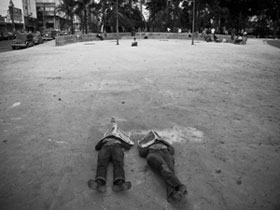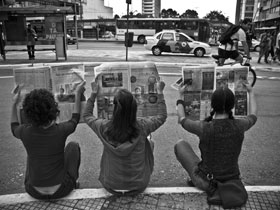Programme
Opovoempé
Brasil
OUT OF KEY(S)
installation and series of performances
5 - 15 May 2008
performances:
7 May 2008 at 3pm
crossing of Veceslav Holjevac avenue and Dubrovnik avenue 
9 May 2008 at 3pm
crossing of Holjevac avenue and Ljubljana avenue (by Holjevac statue) 
12 May 2008 at 3pm
Main train station, by the entrance to Importanne centar 
13 May 2008 at 3pm
Bana J. Jelacica Square 
15 May 2008 at 11am
Dolac 
15 May 2008 at 3pm
Dubravkin put 
installations:
Dolac - summer theatre Tuskanac - Marticeva (near Badel ex-factory) - Savski nasip - park Travno (by the kindergarden) - Tresnjevka market 
Opovoempé: Ana Luiza Leão, Cristiane Zuan Esteves, Graziela Mantoanelli, Manuela Afonso, Paula Possani
Doors are passages, they have two sides, they mark the boundary between two dimensions. To pass through them implies a certain choice.
Regrets that are to come, are they taking shape even today, in our careless and uninformed actions, in our fears and our avoidances? And will we one day regret these choices?  And does this make our actions harder and more awkward? If only we could stand in front of this door and turn back the time, or move it forward...
And does this make our actions harder and more awkward? If only we could stand in front of this door and turn back the time, or move it forward...
Flexible walls, mobile boundaries, or the paradox of seeing divisions where there are none. Opovoempé makes choreographies and collective images with doors that separate nothing. They carry them around, choreograph them, place them as barriers in paths where passage is usually unobstructed, leave them standing freely as installations that emphasise the potential of space. A peek through the spyhole always alters one dimension - space or time.  Through a series of performances, the performers wish to tear up communication barriers, drag humour, play, hidden social facts and tensions out to the surface.
Through a series of performances, the performers wish to tear up communication barriers, drag humour, play, hidden social facts and tensions out to the surface.
Opovoempé means literally "people on feet". The group's work is focused on the corporeal, on activation and the development of a creative performer. It also demands a lively interaction from the viewer, who is stimulated to experience, imagine, interfere, create etc. They say about their interventions that they're not only artwork, but also a method of researching the human condition and the boundaries of the theatrical act, a method which obfuscates the boundary between art and life.
